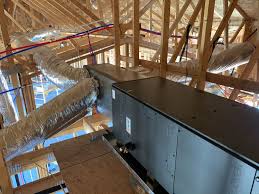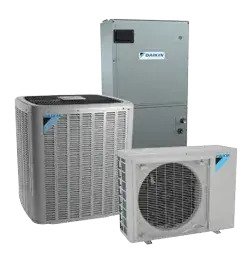Ducted heat pumps are popular for homeowners and business owners who want to use energy-efficient systems to heat and cool their indoor spaces. These systems offer many benefits, including improved comfort, lower energy bills, and reduced environmental impact. In this article, you will learn the basics of ducted air source heat pumps, how they work, and some pros and cons of using these systems.
Ducted heat pumps, also known as central air systems, are HVAC (heating, ventilation, and air conditioning) systems that use ducts to distribute warm or cool air throughout a building. These systems have two main components: an outdoor unit and an indoor unit. The outdoor unit contains a compressor and a condenser, while the indoor unit includes an evaporator and a fan.

How Do Ducted Heat Pumps Work?
Ducted heat pumps transfer heat from the outdoor air to the indoor air, or vice versa, depending on the season. During the cold season, the outdoor unit extracts heat from the outside air and transfers it to the indoor unit, which is distributed throughout the building via ducts. During the cooling season, the process is reversed, with the indoor unit extracting heat from the indoor air and transferring it to the outdoor unit, where it is released into the outside air.
Advantages of Ducted Heat Pumps
· Energy Efficiency: One of the main advantages of ducted heat pumps is their energy efficiency. Unlike traditional heating and cooling systems that burn fuel or use electricity to generate heat, ducted air source heat pumps are designed to transfer heat from one place to another, using only a small amount of electricity to power the compressor and fans. This means they can provide the same level of comfort as other systems while using significantly less energy, resulting in lower energy bills and reduced carbon emissions.
· Consitant Heating and Cooling: Another advantage of ducted heat pumps is their ability to provide consistent and even heating and cooling throughout a building. Because the air is distributed through ducts rather than individual units in each room, so the temperature remains consistent throughout the building, without hot or cold spots. This can lead to increased comfort and reduced energy usage, as the system can be set to maintain a consistent temperature rather than having to adjust individual units to maintain a comfortable environment constantly.
· Healthy Indoors: Ducted heat pumps are also a good choice for those who want to maintain a clean and healthy indoor environment. Because the air is filtered through the ducts before it is distributed throughout the building, ducted heat pumps can remove dust, allergens, and other pollutants from the air, enhancing indoor air quality and reducing the risk of respiratory problems.

Disadvantages of Ducted Air Source Heat Pumps
However, there are also some disadvantages to using ducted heat pumps. One of the main drawbacks is the upfront cost. While ducted air source heat pumps can provide significant energy savings over time, they can be more expensive to install than conventional heating and cooling systems. This is because they require ductwork to be installed throughout the building, which can be a time-consuming and expensive process, especially in older buildings.
Another potential drawback of ducted heat pumps is that they may not be the best choice for buildings with uneven heating and cooling needs. Because the air is distributed through ducts, it can be difficult to maintain a consistent temperature in areas of the building that are further away from the indoor unit or that have different heating and cooling needs than other areas. This can lead to increased energy usage and decreased comfort, as the system may have to work harder to maintain a consistent temperature throughout the building.
How is a Ducted Heat Pump Installed?
Installing a ducted heat pump involves several steps and can be a complex process that requires professional installation. Here is an overview of the installation process:
1. Site evaluation: A professional HVAC technician will first evaluate your property to determine the best location for the outdoor and indoor units. They will also assess the existing ductwork or determine if new ductwork needs to be installed.
2. Indoor unit installation: The indoor unit, which consists of the evaporator coil, blower, and air filter, is typically installed in the attic, basement, or closet. The unit is mounted on a metal stand or hung from the ceiling, and the technician will connect the evaporator coil to the ductwork and install the air filter.
3. Outdoor unit installation: The outdoor unit, consisting of the compressor and condenser coil, is typically installed on a concrete slab or a bracket mounted on the side of the building. The technician will connect the outdoor unit to the indoor unit with refrigerant lines and electrical wiring.
4. Ductwork installation: If new ductwork needs to be installed, the technician will install the ducts throughout the building, typically in the ceiling or floor joists. The ducts are connected to the indoor unit, and each room has a supply register or vents to distribute the heated or cooled air.
5. Electrical and controls: The technician will wire the electrical connections between the outdoor and indoor units and install the thermostat or control panel. They will also test the system to ensure it works properly and make necessary adjustments.
6. Final inspection: The technician will conduct a final inspection of the system to ensure it meets local building codes and safety regulations.
7. Overall, installing a ducted heat pump requires specialized knowledge and training and should only be performed by a licensed HVAC professional. A professional installation will ensure the system is safe, efficient, and reliable and help you maximize your investment.
Does it Worth Utilizing Ducted Heat Pumps in Toronto?
Using ducted heat pumps in Toronto can be a cost-effective and efficient way to heat and cool your home or business, depending on your specific circumstances.
Toronto has a climate that experiences hot summers and cold winters, making ducted heat pumps a good choice. Ducted heat pumps can provide heating and cooling throughout the year, making them a versatile solution for Toronto’s variable climate.
In conclusion, ducted heat pumps are an energy-efficient and effective way to heat and cool indoor spaces. They offer many advantages, including improved comfort, lower energy bills, and better indoor air quality. However, they can also be more expensive to install than traditional heating and cooling systems and may not be the best choice for buildings with uneven heating and cooling needs. If you are considering installing ducted heat pumps in your buildings, contact us (HVAC company) and we will help you out.
